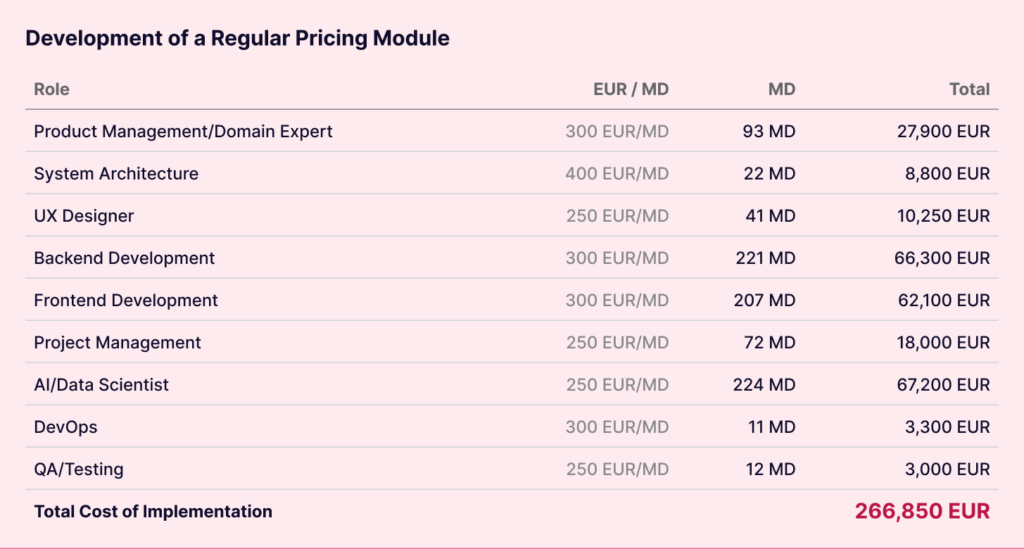Retail organizations are evolving towards the future at the speed of light, mainly due to technological advances in recent years with ML/AI and modern pricing techniques. As such, the question no longer is if retail businesses need pricing tools or pricing software, but which ones are best suited for their needs. Based on our recent conversations with real experts on this matter, and almost a decade of modern pricing technological research and development, we have found one major consideration to be a near make-or-break business decision:
Should our retail business build its own in-house pricing tool, or purchase a specialized price management software from an external vendor?
Picking The Right Tool for the Job
Is your retail organization considering building an in-house tool to help manage prices? Good idea – managing prices without specialized and truly competent pricing technology is an almost impossible feat in today’s high-paced and super competitive retail market, in virtually any industry. However, have you considered the full scale of costs, risks, and the likely end results you will achieve with an in-house pricing tool?
Some questions to consider: Will an in-house tool be specialized enough to be truly competent and effective in achieving our objectives? Is it the right choice for our organization from a financial standpoint? Can we scale the in-house tool and maintain it accordingly for it to be truly useful for more than 1 or 2 years? Would it possibly be wiser to simply leave this matter in the hands of true pricing technology experts who build tailor-made price management solutions for retailers, and maintain them regularly?

In this white paper, we aim to help you make an informed decision based on real-world figures and experience from our in-house experts, an interview with a prominent tech and business leader from a well-established retail organization, and a wealth of field research.
A Question of Feasibility
Most retail firms, both large and SMB, need competent retail price management of some sort in order to maintain competitive prices and promotions that do not damage customer price perception and margins. As such, it is not unusual for retailers to aspire to take control of their pricing, one way or another. Yet, the goal of building a suitable or even competent in-house pricing tool is feasible for some, and absolutely unfeasible for others, for multiple reasons.
The consideration of whether or not to build an in-house tool or go with a specialized external price management provider is not simply about money. It’s also about complexity in SKUs, store locations, competition on the market, and a myriad of other factors.
Let’s quickly evaluate the three most common alternatives to an external price management vendor solution.
Weighing Out Alternatives
We have come across cases where major retail players felt confident in their tech people’s ability to build their own in-house pricing tool. We also have been told that a black-box solution implemented by a Big 4 consultancy firm was the option some prospects preferred. And, there also exists the case of those who are not ready to commit to any form of true pricing technology.
These cases are rare, but here are the three main alternatives to purchasing a dedicated price management product that we’ve encountered:

1. Build an In-House Pricing Tool
In the case of major retail players, spending almost 1 million Euros per year on building an in-house pricing tool and sustaining future maintenance is likely feasible. They may even have a team of people who can pull this off in 3 to 5 years and deliver great long-term results. Yet again, perhaps the opposite will happen, and we’ve also seen plenty of cases where DEV teams are floundering as they struggle to build a product that delivers desirable results, all while their Sales Team, Pricing Managers, and CatMan team begin to demonstrate extreme frustration and doubt if the tool they are building will ever work correctly – many working hours are wasted in these heated discussions.
As such, some questions these top firms should consider are: Do we know our end goals and how to get there with our own in-house tool? Is this really a better and more profitable option than simply buying a dedicated price management software? Will we incur major business risks and exuberant expenses in the process? Should we maybe just let dedicated teams of price management technology professionals deal with this to spare ourselves the headache and the likely issues and stunted margins that can come with it?
If an organization can get past major development challenges, the heavy financial blow of an in-house tool project, and build within 5 years, we have heard of a limited and very rare number of success cases with an in-house tool that organizations maintain and scale into the future with really great results. But, more often than not, an in-house tool build leads to wasted time, money, and resources.
2. Hire a Big 4 Consultancy Firm Black-Box Solution
Sometimes, visibility into how the figures are rendered by a pricing tool are not important to retailers. The important thing is to get results that drive revenue and sustain margins, and their pricing managers may not have to do much legwork or truly understand the figures they are obtaining from the black-box tool in order to continue driving positive results. Needless to say, few retail businesses can ever rely on such a lack of visibility, which can limit future margin and revenue growth and give little control over prices to the organization and its pricing experts. A handful of demo calls and discussions with prospects we’ve had in the past were about organizations running away from black-box fiascos.
We will be writing an article on the topic of black-box solutions very soon. As it differs from our current consideration between in-house solutions and commercial price management software, we will leave the deeper analysis of this subject matter for later.
3. Can’t Afford/Don’t Benefit from Specialized Retail Price Management
Typically, upper management of small retail organizations may say,“Do we really need this right now? Won’t we be able to do the same on our own with the Excel sheet everyone is accustomed to using?” The fact of the matter is that Excel and spreadsheet-like tools have always been used in some manner for pricing — since the era of ARPANET (time to evolve into the future, maybe?).
If your pricing needs are limited to a couple hundred SKUs, or if you serve a very niche market with limited products, maybe a thorough price management software is overkill. But, this scenario is very rare. In almost all cases, a competent pricing solution would absolutely have a much greater positive impact on margins compared to Excel, but the urge to invest in it needs to be there.
You can try our free Sales Margin Forecaster to find out if your business will benefit from a dedicated price management software.
With the above info, let’s now take a look at the pros and cons of building an in-house solution, versus using a specialized price management software from an external provider.
When to Consider Building In-House Pricing Tools
As mentioned above, large retail organizations with massive financial backing absolutely have the capital to fund their own in-house pricing project. We’ve even detailed these figures below to help give further transparency and clarity into this topic. In these cases, it may be advisable to build an in-house solution — but, it will not come without recurring notable investment on a yearly basis, nor without loads of man-hours and issues to solve.
If the figures below seem reasonable, if you have the technological and business know-how to make it work towards your specific end-goals, and if the risk of failure is not sufficient to ruin the business, an in-house pricing tool may be all you need, and it could even be your best option.

The Cost of Building an In-House Solution
Our CTO Jiri Psota has experience in building multiple retail SaaS businesses. As such, he brings a wealth of past experience into the picture regarding the overall costs for development of an in-house solution. According to his calculations, the overall cost of building a basic in-house tool is approximately 924,560 EUR (bulk pricing module not included).
You can see his figures and calculations in the table below:
TCO of an In-House Pricing Tool




If the TCO of an in-house tool works for the aims and budgets of your organization, along with the need to maintain the tool and keep it up-to-date (also, a considerable expense of several hundreds of thousands of Euros per year) then it could be a viable option from a financial standpoint. But, as we are about to see, there are a whole host of other critical considerations and potential pitfalls to bear in mind.
In-House Solution Architect Expert Opinion Interview
For the purposes of this article, we got an expert opinion from someone who has actually built a successful in-house pricing tool for his organization in recent years. We needed someone who also happens to use Yieldigo as an external price management software provider for their current role. And, of course, who is not a member of our organization and can therefore speak freely based on their professional point of view — a neutral expert perspective with thorough experience in these matters.
As such, we had the pleasure to speak with the Group Head of Pricing at Kosik.cz, and previously the in-house solution architect for Rohlik.cz, Filip Skala.
Interview with Filip Skala, In-House Solution Architect and Group Head of Pricing

1. Hi, Filip! Thank you for joining us today. You’ve led in-house pricing tool builds in the past. Could you tell us a bit about how these projects looked and evolved from start to end?
Hi, sure thing, happy to help! At Rohlik.cz we had 9 dedicated DEV team members working to build an in-house tool for rohlik.cz. The company and DEV department made a unanimous decision to build an in-house solution. Part of the reason why is that rohlik.cz had a strict rule to not buy external solutions since they wanted to truly own their pricing decisions without outside influence. Overall it went as well as possible, but we were not able to foresee all of the issues that would come up on the way. The tool took 4 years to build from scratch, even though it only took 2 quarters to build the core module. To this day it continues to be evolved as is the case with all pricing solutions, they must be maintained and continuously improved upon.
The timeline of the key modules for basic functionality of our in-house tool at rohlik.cz was as follows:
- Planning, Meetings, and Tool Conceptualization: 24 months (total approximation)
- Core Pricing Module: 6 months
- Product Families: 2 months
- Smart Rounding with Psychological Thresholds: 2 months
- Sizing Families: 2 months
- Last-Minute Module: 3 months
- KVI Scoring: 2 months
- Automation Scoring: 3 months
- Promotion Planning Module: 6 months
- Promo Forecasting Module: 2 months
- One-Day Promotions for Fresh Products: 1 month
The context of building our own in-house tool was as follows: Rohlik.cz had a pricing tool of some sort at that time, as well as a very solid collection of competitor data. At the start of the build, we managed data scraping internally, but as our number of competitors grew, we began to outsource our data scraping process out of necessity. I came up with the idea to create a new pricing solution that would use this surplus of data we had all while improving upon our previous tool.
Most price engines work around constraints. I stripped the Gross Margin out of the equation and instead focused primarily on creating what I have referred to as an “Image Competitor” model. I find the results from constraint-based tools to be difficult for end-users to follow. As such, if a category manager or pricing manager can’t trace or understand the calculation process behind the figures they render from their tool, then their approach to pricing is fundamentally flawed.
The “Competition Model” approach we built is based on mathematical precision data modelling, considering every variable to find some kind of optimization of prices based on the importance of the product. The goal of this competition model was to provide us with the best reference price currently available on the market. We identified certain competitors as role models and gave them different levels of preference depending on how close they approximated to our end-goals. For example, if they strayed too far from the market by becoming significantly more expensive, then we chose not to follow that particular competitor’s pricing and instead referred to another competitor with aims that aligned more closely with ours.

We also assigned extra points to certain products and families of products for being more important to our customers. We then would also take the non-competitor-image prices with the target price indexes that give us a bigger advantage against our other competitors. In other words, we built the categories based on other players in our markets and their market data. The customers will compare your private label product and major brand products to the prices in other retail shops.
We developed this tool with a similar approach to Yieldigo based on category, brand of products, rules, different constraints, and so forth. But, our tool had less modules and features than Yieldigo, the aim was not to be as thorough but to at least fulfill our core pricing needs. We also had to do the testing phase, all within the span of those 4 years. In terms of regular pricing, everything was automated.
Thereafter, we also created a promotion module, but no bulk pricing. The reason why we could not do bulk pricing is that we had technical complications to create a multibuy tool due to how the tables were built – it was impossible to create separate pricing tiers. The different database needs for each pricing tier made it extremely difficult.
Overall, the build was an extraordinarily complex and difficult process. Even to simply figure out what was the best approach for us in order to achieve this was not an easy conclusion to come to and unanimously agree upon. Our realization that a competitor focus was the most critical consideration by analyzing the “Image Competitor” model was in itself a daunting task. And then we had to actually build it and get it to generate the most accurate results possible.
Kosik.cz, however, has never used an in-house solution and has never built one. Our approach to retail at kosik.cz is different from rohlik.cz, and thus we benefit from using Yieldigo price management.
2. What challenges do DEV teams, and all teams involved, face when building in-house tools?
The three biggest challenges we faced were as follows: First, it was a major challenge to get aligned with the Sales Team. It’s truly complicated because from the start of the in-house tool build, you don’t have correct, or let’s just say, the most accurate data about product prices. And the Sales teams know their business — they know that these prices are off. As such, by default, it is normal that they distrust the solution. Worst of all, it’s hard to react fast to the market and the changes that arise with it, all while simultaneously delivering correct figures, and without any errors in the process.
The reality is that the solution has to be FAST, — super-fast — at delivering what the CatMan people need. And I was between the tech teams and the business solution that was needed for the job. As said within Adam Smith’s The Wealth of Nations, the market reflects price advantages. 10 years ago, it was not the case that we had this price advantage information so readily available. But today, it is rapidly accessible to anyone.
That’s the reason why it’s a technological trend that must be studied and captured mathematically. It is not dictated by the will of the CatMan people, but the will of the market and the fast changes in its prices. Keeping up with the CatMan team’s needs and perspective as well as our DEV team’s is extremely difficult, and it definitely posed many notable internal issues. This process was taking away attention from being able to focus exclusively on promotions and this is what drives the traffic of sales and volume. Not every retail organization will be able to weather all of these internal pricing and technology team storms, and these distractions can be costly for business.
This is especially problematic from the Sales team’s perspective because they see this as something that should be rendered for them with ease, and as matter of fact. You can’t blame them — they are used to knowing their business and want to work with tools that help their job, not hinder it. Therefore, having faith in the solution from everyone at the beginning of the build is very difficult, and does lead to long-winded discussions and lots of headaches that can often break apart teams and create more financial setbacks for the business.

Data clearance was the second biggest challenge. Lots of things can go wrong, such as updates to the website where the system you’ve established can erroneously identify regular prices as promotional ones, even if they are not. As one can imagine, this would be a great way to lose money if customers lost trust in our prices from such a silly mistake. Once again, this also damages the Sales team’s trust in our in-house solution efforts.
And third, making the final step towards full automation, which by default means stripping away decision-making power from the CatMan people, at least partially. We want them to be experts on promotions and customer preferences — and they indeed have been the owners of profitability for retail organizations in the past, especially 10 years ago. But, the fact of the matter is that now they can find prices of almost any item in 10 seconds or less on Google, or by looking online for this info. As such, every player on the market observes each other and reacts based on these fluctuations.
3. What are the pros and cons of building/using an in-house pricing tool for retail businesses? Does an in-house tool offer the same visibility and ease of use as well as maintenance as a dedicated retail price management solution?
Honestly, I have found both solutions to be equally expensive, but only assuming the in-house solution you’ve built is working well for you (if not, then it is costing you a fortune more, of course). But, if executed in the most optimal way possible, the cost is plus/minus the same overall. If someone thinks that an in-house tool is cheaper, they are absolutely wrong — it will almost certainly cost the same, if not more, depending on how well it is executed and how difficult it is to maintain.
A big advantage to purchasing a commercial solution like Yieldigo is that you can be super flexible and change your approach from one week to another. It’s not set in stone like an in-house tool. If you want flexibility and want to experiment with your pricing to find what is best for your business, then definitely go with a dedicated external retail price management software provider.
The fact of the matter is that when you want to change your approach or strategy in an in-house solution, the process is much more complicated — the change in objectives is more difficult to achieve, and costs significantly more time. Needless to say, you will have to once again go through the same routine of issues between teams and company-wide doubt in the in-house tool you’re building. Point being: You are able to navigate different strategies and approaches much faster with an external dedicated price management software than an in-house tool.
With an in-house solution you must have an extremely clear vision of what you must do as an organization to succeed in your goals. Nothing is ready-made, and it’s all up to you. Without this level of ownership and business-direction, the build is destined to failure or very painful and costly errors. You need the right people who can develop this together, but also they need someone who can design it and have the business know-how to apply it accordingly to company end-goals for profit and margin retention.

4. Would you recommend retail firms to build in-house pricing tools, or would you say that purchasing a dedicated retail price management software is easier, better, or more viable? Which delivers better results?
Again, it really depends on your resources and goals. If you are sure of what your approach is, the in-house solution gives you the more tailored solution that you can be more in control of in terms of your specific needs. Rohlik.cz is an exceptionally technically developed company, which is why they can pull this off. They know their business and have a uniquely powerful DEV team that can create an architecture — the tool can be sustained and scaled with time.
However, if you cannot afford to build such a solution or if the risk is simply too large (as it is for the grand majority), then definitely dedicated price management software from an eternal vendor like Yieldigo is by far the better option. And, when you know the business, but not the technology to build it and maintain it properly, go with a commercial solution. But, if you really know what you need to build and how (and have the resources to survive the build process and maintain it into the future), go with the in-house build.
5. What other thoughts or pieces of advice could you offer to us on this topic?
Let’s face it — you can have an excellent product-oriented sales structure and logistics prowess like LIDL, which is pure gold, but extremely rare. When this is not the scenario for your retail business, going with a tech-driven approach is the right option and a good one with less hours of work behind it. Regardless, the need for tech is the norm for most retail businesses to thrive. Therefore, one way or another, you will almost surely need pricing technology.
It’s tempting to think that building an in-house solution will solve all of your problems and even spare you the cost of purchasing a dedicated price management product. Even if you have a great team and capable developers with great drive and vision, you still need to have somebody who can unify this into a technology that works for the business. Short of this, and what could be a great way to own your own pricing methodologies can very rapidly turn into chaos and damage your business. Think carefully before you commit to an in-house tool build because it may not be possible to achieve. It will also be more difficult to test different pricing strategies and approaches with.
In the end, a competent external retail price management solution is in almost all cases your most risk-free and sure choice with the greatest flexibility, breadth of features, and technological depth as well as maintenance. But, sure, in the right hands and circumstances, an in-house tool can indeed deliver great results and I can recommend either depending on the scenario in question.
5 Clear Advantages to Purchasing an External Provider Retail Price Management Software
Competition for share of wallet while maintaining healthy margins is a difficult and delicate balancing act, one that cannot be taken lightly without serious consequences. Pricing technologists who build dedicated software for the job will almost certainly always be your safest bet. What are some key advantages of purchasing an external vendor price management software?

1. Built by Retail Pricing Pros for Retail Pricing Pros
Dedicated price management software providers make a living from being pricing solution experts. They build ready-made solutions for retail pricing professionals to use with ease, almost entirely ensuring price management success with the product.
Also, retailers using specialized external solutions are not just applying software with no further assistance – in most cases, they are getting a team of professionals to help them with implementation and onboarding all the way through to product usage and customer support. They gain access to a specialized price management system built to ensure that retail organizations are saving their margins as much as possible, and allowing them to focus on retail business without extra expenses, risks, and headaches.
2. Low-Risk Price Management that Delivers Results
As we saw in our interview with Filip Skala, of course an in-house tool may resolve all of your immediate needs well, while allowing you ultimate control over the figures it delivers. But, there is a very high risk of failure or inaccurate figures. A vendor-built solution from an external provider removes the risks that come with in-house tools, and puts your team into the capable hands of pricing technology experts. This assurance is almost in itself one of the greatest advantages to purchasing a dedicated price management software. And, competent external price management solution vendors nowadays also give you full control over your tailor-made pricing strategy based on your data, no black-box!
3. Flexibility to Craft New Pricing Strategies with Ease and Make Fast Changes at Will
Also according to Filip Skala, the ability to change pricing approach and strategy is easily done with a dedicated price management software, but not an in-house tool. This is critical for organizations that are aspiring to grow their business prowess in terms of using pricing to retain margins more effectively and even drive profits further. If a retail business is still trying to understand which pricing approach works best for all of their thousands upon thousands of SKUs, then it is highly likely that an in-house solution will lead to dead-ends and a cumbersome inability to quickly change a flawed approach.
4. Implementation Assistance, Product Maintenance, and Support
One critical reason why in-house tools are high-risk is because the total cost of ownership includes product maintenance, security updates, evolution of new technologies to keep up with competitors and their pricing solutions, and loads of other serious expenses. Speaking for ourselves at Yieldigo, our team offers fast implementation times (12-14 weeks) guided by our experts who work with pricing and tech teams, and of course regular maintenance and some of the best technical support and customer service you can find. Don’t believe us? Feel free to check out our reviews on G2.
Regardless, keep in mind that the external providers are there to serve you and your organization, and this will also help facilitate daily pricing needs.
5. Reduced Costs and Headaches
As we saw in Filip’s example above, setting up the in-house pricing tool at rohlik.cz came with a lot of internal drama. The Sales and CatMan teams’ scrutiny and distrust of the in-house tool and the 4 years it took to build it (without a bulk pricing module) all generated large amounts of meetings, extra work, and stress. When considering all of the time and effort this process consumes, then it can be seen as a major advantage to let the external provider deal with the price management headaches, so that retailers and their teams can get back to business that actually generates optimal results.
5 Critical Considerations When Building an In-House Pricing Tool
Building an in-house pricing tool comes with a lot of caveats and potential problems. A cost-driven business like retail requires cost-efficiency. With this in mind, the in-house solution, for various reasons, is anything but cost-efficient.
We were able to think of some reasons as to why staying away from building an in-house solution may be prudent and best for your business:

1. Large Investment of Time and Money
As we detailed above, you would need to invest upwards of 1,000,000 EUR in R & D, Development, Design, and other expenses to benefit from truly modern technological prowess for an in-house tool. But, this is not a one-time payment, since every year investing into maintenance of the tool will also come with very large expenses.
2. Penetration Testing and Critical Security Needs Are Not Optional
You will not create it once and have it forever, you must stay on top of its technological evolution and security daily. Keeping up with the security alone (and all critical security updates) is a full-time job in itself, along with the need to update it to ensure it is keeping up with relevant technologies. Also, it requires the regular penetration (VAPT) testing and security recommendations that come with it, as well as new versions of security manuals for both the software and also the DevOps infrastructure behind it. Your team will also need to consistently prove that the application is still secure and that there are no new vulnerabilities. A security breach on something like prices from suppliers (cost prices) would mean having your retail organization’s reputation damaged for losing customer data, not to mention potential legal issues as well as fines.
3. High-Availability and Disaster Recovery Is a Must!
High-availability and disaster recovery needs to be in place — the risk of losing all of your pricing data and figures is too high and simply not worth the nightmare it could bring upon a retail business. The tech teams must stay on top of this and test it every quarter, if not every other quarter at bare minimum (every 3-6 months) to be sure that you are ready to respond to service interruptions and enable system recovery. Without High Availability and Disaster Recovery set in place accordingly (also very expensive to maintain), the risk already outweighs the benefits.
4. Staying Up to Date with the Tool for Mere Functional Purposes
By not keeping up with your in-house tool and relevant technology updates on a yearly basis, at bare minimum, you cannot expect that your original build will be viable in the near future. Haphazardly adding on new technologies like standalone plugins renders poor results that cannot scale — it won’t work, and you will likely have to do a partial if not complete rebuild of the original in-house tool, meaning loads of time and money wasted. Staying up to date is not just about technological evolution, it is also about how it scales and grows on a functional level for your business.
5. Lack of Market Feedback to Evolve the Tool According to Your Competition’s Standards
On a product level, once you are building your own in-house solution, you only have the judgment and criterion from your internal people, and nothing from anyone external that alerts on the technological standards evolving within the entire market. In the case of external price management software vendors, feedback on the product from end-users using other products helps them to continuously evolve at the same speed as every software on the market. Your internal team of people cannot replicate the huge amount of feedback that external software providers receive from end-users and prospects, so keeping up with new trends and needs is much more challenging for retailers relying on in-house tools. You would need extremely expensive consultations from firms like Deloitte, McKinsey & Company, and so forth to keep up with the trends without ear-to-the-ground feedback.

Conclusion
An in-house pricing tool can indeed be the best option for a select few retail firms that can afford it — but very few will succeed in building a tool that delivers desirable results, all while incurring potentially business-crushing expenses. As we have seen, the costs and risks are considerable, even for large retail businesses. The reality we have presented is that an in-house solution can absolutely be the right choice for a retail firm that has the right financial backing and preparations as well as the business know-how and DEV resources available. However, more often than not, it is a brutal test of time that comes with several serious pitfalls and business dangers that generally do not offer any advantages or desirable results.
Whatever your retail business decides, never forget that doing your due diligence and making a prudent decision will never lead you astray. And, when in doubt, the external providers offer retail price management solutions that deliver arguably more valuable actionable results and more flexibility in pricing strategy approach than an in-house tool, without massive risk.
If you would like to learn more about Yieldigo price management and how we can be the better alternative to an in-house tool for your retail business, you can talk to our pricing expert.


